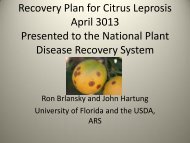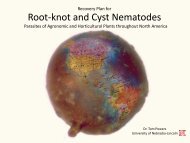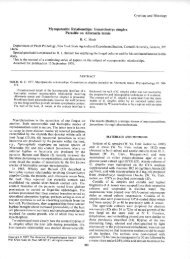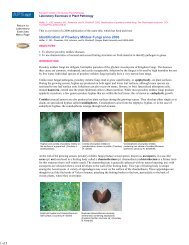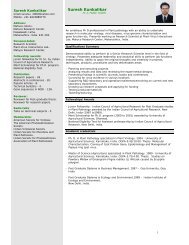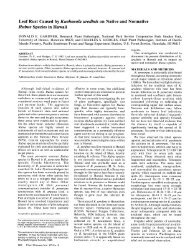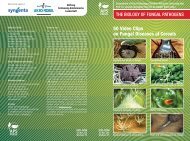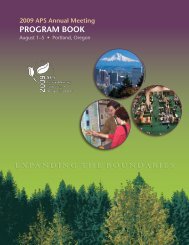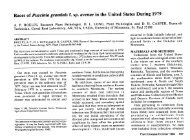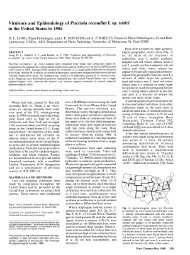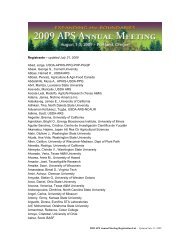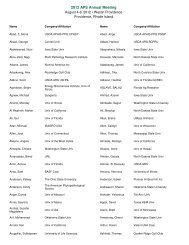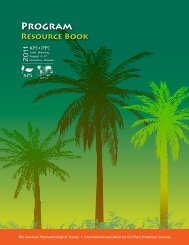view article - American Phytopathological Society
view article - American Phytopathological Society
view article - American Phytopathological Society
You also want an ePaper? Increase the reach of your titles
YUMPU automatically turns print PDFs into web optimized ePapers that Google loves.
A biopesticide seed treatment using a strain (KRL-AG2) of T. Twelve isolates of Talaromvces flavus were examined for their<br />
harzianum produced by protoplast fusion is being developed-for capacity to"' parasitize pre-dried sclerotia of Scletrotium rolfsii<br />
control of plant diseases. In 1988, field trials were conducted on water agar (2% Bacto agar in tap water) and in natural sandy<br />
in five states, i.e. Florida, Idaho, Mississippi, New York and<br />
Texas. Crops included cabbage, canola, cotton, cucumber, snap<br />
loam soil adjusted to 70% MHC. The dried sclerotia<br />
a conidial suspension of T. flavus containing 10<br />
were dipped in<br />
spores/ml and<br />
bean, soybean, sweet corn and tomato. In general, seed treatment<br />
with KRL-AG2 and solid matrix priming provided reliable<br />
and effective control of seedrot diseases. Plant stands from<br />
seeds with biological treatments were equal or superior to<br />
incubated at 30 C for 3-4 days. All the tested isolates<br />
parasitized the sclerotia on water agar, but only 9 were capable<br />
of parasitizing the sclerotia in soil. Dipping the sclerotia in a<br />
heat-activated T. flavus ascospore suspension ( 10 7 those from seeds treated with chemical fungicides. Biological<br />
seed treatment increased yield in sweet corn and slightly increased<br />
effective yield mixtures in cotton of fungicides.<br />
relative to<br />
Expanded<br />
seed treatment<br />
trials,<br />
with<br />
including<br />
highly<br />
spores/ml),<br />
resulted in up to 5% mycoparasitism of the sclerotia in either<br />
water agar or soil, as compared to 5-100%, depending on the<br />
isolate and on the medium, obtained with T. flavus conidia. The<br />
differences in mycoparasitic capacity observed among the tested<br />
additional crops and states, are planned for 1989. T. flavus isolates were found to be correlated with their growth<br />
rates as well as with their glucose oxidase, 0-1,3-glucanase and<br />
chitinase activities.<br />
197<br />
EFFICACY OF BINUCLEATE RHIZOCTONIA AGENTS (BN) IN BIOCONTROL OF 201<br />
RHIZOCTONIA ROOT ROT OF SUGAR BEET IN THE FIELD. L. J. Herr, DIRECTEDENHANCEMENTOFBIOCONTROLINPSUEDOMONAS BY<br />
Dept. of Pl ant Pathology, Ohio State Univ., Wooster, OH 44691. CONSTITUTIVE ANTIBIOTIC BIOSYNTHESIS. W. HowŽie, D.Matsubara, N. Gutterson,<br />
and T. Suslow. DNA Plant Technology Corportation, Oakland, CA 94608.<br />
Similar field tests of three BN (as biocontrol agents) were run Constitutive biosynthesis of oomycin A in Pseudomonas fluorescens strain Hv37aR2<br />
on on88. a silty silt clay aygloam loam (SC) (SC) and and a a) plusand sandy loam loamt (SL) ( tol,<br />
soil during<br />
durig was achieved by placing a strong promoter<br />
.............. .....<br />
1988. BN agents (1, 3 and 4) plus no agent controls, wereofhaulounstomcnbsyheiw<br />
sequence upstream of an introduced<br />
mntreyiomnsce<br />
copy<br />
banded over rows at two rates (11 .2 and 67.4 kg dried barl ey of the afuE locus. In situ oomycin A biosynthesis was monitored by bioluminescen<br />
inoculum/ha) in early June. On 15 June, beets were side- from a reporter afuE-Iux fusion in either a constitutive (WH157) or control (WH161)<br />
dressed win R.eslar ne. On- 2 barley Jne, beets u were side-strain. Biosynthesis of oomycin A ifn situ was determined over a 7-day period in both<br />
dressed with R. sol ani AG-2 ,T2 barley i noculum (45 kg/ha), strains. Biosynthesis in strain WHi157 was consistently 50 to 100-fold higher than in<br />
Harvest (10 Oct) data taken were % plant loss (% PL); disease strain WH161 on seeds, roots, hypocotyls, and cotyledons of<br />
rating<br />
cotton,<br />
(DR),<br />
Acala<br />
on a scale<br />
SJ2.<br />
of O=healthy to 5=80-100% rotted; and There were no significant differences in populations of the two strains on<br />
yield.<br />
any of<br />
On SC, BN-1<br />
the<br />
and 3 agent treatments (not diff.) had plant parts assayed. Seed treatment with WH157 resulted in an average of 15 to 20%<br />
lower % PL, DR, and a >50% increase in yield over the BN-4 increase in emergence and decrease in root infection by Pythiumultimum as<br />
agent and<br />
was<br />
no agent<br />
signi fi cantly was beter better<br />
(not ignficntl diff.)<br />
than hanthe11. the<br />
treatments.<br />
11.2 kgha kg/ha<br />
The rtehowverthe rate,<br />
67.4<br />
however<br />
kg/ha rate<br />
the compared rhizobacterial to strain strain WH1 can mitigate 61. Clearly, deficiencies<br />
constitutive<br />
in efficacy.<br />
antibiotic biosynthesis by a<br />
rate x agent interaction was non-significant. Whereas on SL,<br />
the rate x agent interaction was significant and BN-3 at 67.4<br />
kg rate ranked best in all categories, including a 383%<br />
increase in yield over the no agent treatment. 202<br />
A NEW BIOCONTROL FORMULATION FOR TRICHODERMA AND GLIOCLADIUM.<br />
EFFECT OF SUBLETHAL HEATING ON WEAKENING, AND ON HEAT SHOCK<br />
PROTEIN SYNTHESIS, IN PROPAGULES OF FUSARIUM. S. Freeman, C.<br />
Ginzburg* and J. Katan, Dept. Plant Pathology & Microbiology,<br />
Faculty of Agric., Rehovot 76100; and Dept. of Ornamental<br />
J.A. Lewis, G.C. Papavizas, and R.D. Lumsden, USDA, ARS, Horticulture, The Volcani Center, Bet Dagan 50250, Israel.<br />
Beltsville, MO 20705.<br />
Biocontrol formulations were prepared with vermiculite, wet fermentor<br />
biomass of isolates of Trichoderma spp. and Gliocladium<br />
virens, and dilute HC1. The mixture was air-dried and activated<br />
The weakening of propagules of F. oxysporum niveum (FON) by<br />
sublethal heating may be expressed in a delay in germination,<br />
and in reduced survival and disease incidence. Germlings of<br />
FON respond to heating by synthesizing a set of heat shock<br />
with wheat bran and additional dilute acid to develop germlings<br />
(actively-growing hyphae) of the fungi. Aseptic conditions did<br />
not have to be maintained during formulation and activation.Dry<br />
proteins (HSPs) corresponding to 95, 83, 80, 74, 70, 35 and 18<br />
kD. Vital fluorescent staining in germlings decreases in<br />
intensity which corresponds with appearance of HSPs. HSPs are<br />
preparations survived in storage at 5 and 25 C for at least 12 observed 10 min after heating. Recovery from a shock of 40 C<br />
wk. 9ungi in activated preparations proliferated in soil up to<br />
2x10 cfu/g of soil within 1 wk of amendment. Several preparis<br />
more rapid at 25 C than at 36 C. Thermotolerance to a<br />
lethal temperature of 44 C is acquired by preheating germlings<br />
ations significantly reduced survival ( >60%) of Rhizoctonia at sublethal levels, as determined by vital staining and<br />
solani in pathogen-infested beet seed in soil and prevented<br />
saprophytic growth in soil. Preparations containing various<br />
isolates significantly prevented damping-off of cotton (>60%)<br />
in R. solani-infested soil, damping-off and blight of bean<br />
survival. Solarization at sublethal temperatures may cause<br />
either a weakening or an acquired thermotolerance, but the<br />
direction is probably dependent on the environment into which<br />
the propagules are introduced.<br />
(>90%) in Sclerotium rolfsii-infested soil, and damping-off of<br />
zinnia in soilless mix infested with R. solani.<br />
199<br />
SELECTING FOR ALKALINE TOLERANCE IN TRICIHODERIVL HARZIANUM.<br />
G. Ruppel, USDA-ARS Crops Research Lab, 1701 Center Avenue,<br />
Fort Collins, CO 80525.<br />
E.<br />
203<br />
IDENTIFICATION OF HORTICULTURAL TRAITS FOR PREDICTING BROCCOLI<br />
CULTIVAR<br />
Dept. of<br />
SUSCEPTIBILITY<br />
Entomology and<br />
TO<br />
Plant<br />
BACTERIAL<br />
Pathology,<br />
SOFT<br />
University<br />
ROT. C. H. Canaday,<br />
of Tennessee,<br />
West Tennessee Experiment Station, Jackson, TN 38301.<br />
Triohoderma spp. are favored by soist, acid soils but do persist<br />
in western calcareous soils at low population densities,<br />
which may indicate genetic diversity for alkaline tolerance,<br />
Selections from over 200 random isolates of TrichodeŽ'sno sPP.<br />
were made in vitro at increasing medium pH. One isolate of T.<br />
harzianum (TpH) grew and sporulated on pH 11 medium. At soil<br />
pH 6.7 with six consecutive plantings, TpH and a known biocontrol<br />
isolate of the fungus (THW) at 106 cfu/g significantly<br />
Regression analyses of disease incidence versus horticultural<br />
traits identified three traits useful for predicting the<br />
susceptibility of broccoli cultivars to bacterial soft rot<br />
caused by Pseudomonas marginalis pv. marginalis and Erwinia<br />
carotovora. Data on eight traits thought to influence cultivar<br />
susceptibility were collected in a field evaluation of 25<br />
cultivars and lines maturing simultaneously under disease-<br />
conducive conditions. The percentage of harvested heads with<br />
soft rot (12.2-85.7%o) was regressed on the horticultural traits<br />
suppressed sugar beet damping-off in the first two plantings,<br />
By the sixth planting, treatment effects were nonsignificant.<br />
In soil at pH 8.2 with three plantings, no significant dampingoff<br />
suppression occurred at planting 1, but both isolates suppressed<br />
disease at plantings 2 and 3. At pH 6.7, TpH was not<br />
of 13 cultivars. The best model was head 2 tightness, doming,<br />
and looseness versus disease incidence (R =0.9352; P



